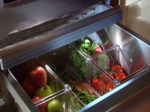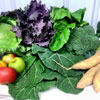It’s a shame to think about how much food gets tossed out each day without ever having been used. Much of this is fruits and vegetables, the very foods that many of us know we aren’t getting enough of. If you find yourself throwing out too much produce, it probably has to do with how it’s being stored.
Proper storage is key, and there are tricks you can use to get the most out of each grocery trip. Here are some tips for preserving fruits and vegetables as long as possible.
Chill Them Out
 Generally speaking, most fruits and vegetables will last longest and taste best when properly stored in the refrigerator. We’ll get to a few examples of what “properly stored” means in a moment.
Generally speaking, most fruits and vegetables will last longest and taste best when properly stored in the refrigerator. We’ll get to a few examples of what “properly stored” means in a moment.
Exceptions to this rule include onions, potatoes, garlic, and winter squash, which should be stored in a cool dry place as excess cold will damage their quality. For the same reason, tomatoes should also be kept out of the refrigerator and instead stored on a counter top at room temperature.
All produce should be kept away from heat and direct sunlight. These help ripen produce, but once picked, heat and light will quickly cause these foods to spoil.
Get To Know Ethylene
Ethylene is a natural gas released by certain types of foods that causes other nearby foods to become spotted or go soft. Some foods that don’t produce ethylene are especially sensitive to it, meaning you should store these two groups apart from one another. Have you ever wondered why refrigerators often have two separate crisper drawers? Managing ethylene exposure is a secret key to preserving fruits and vegetables.
Some common ethylene-producing fruits and include avocados, bananas, melons, and tomatoes. Foods that are especially sensitive to ethylene include apples, potatoes, lettuce and other greens. Keep in mind this comprehensive list of foods that produce ethylene, along with those that are sensitive to it, when you are organizing the food in your fridge.
Lettuce And Greens
 Wrap a whole head of lettuce in damp paper towels, then seal it in a plastic bag and place it in the crisper, which will keep it ready to eat for 7-10 days. Other more delicate greens like spinach and arugula should be sealed in a plastic bag (no paper towels) and will last about 3 days.
Wrap a whole head of lettuce in damp paper towels, then seal it in a plastic bag and place it in the crisper, which will keep it ready to eat for 7-10 days. Other more delicate greens like spinach and arugula should be sealed in a plastic bag (no paper towels) and will last about 3 days.
Store Produce Uncut And Unwashed
Keep produce whole and unwashed when storing, as cutting and excess moisture will both increase the rate of spoilage. You’ll also be preserving vitamin content, as fruits and vegetables begin breaking down once they’re washed and cut up for consumption.
Here is a detailed list of Freezing fruits and vegetables is a great way to extend their longevity, and this can be very useful for those who grow their own produce. Not everything can be frozen however, so take note of what you have and do some research. Follow this link for a great guide on how to freeze fruits and vegetables.
Dry Them Out
Drying produce is another way to preserve these foods for later use. This can also provide unique textures and flavors that they wouldn’t otherwise have.
Some use dehydrators that are specifically made just for this purpose, but simply using the power of the sun works just as well. Keep in mind that you need to properly treat the foods and cut it to ensure no loss of vitamins, such as outlined in these nifty instructions for solar drying fruits and vegetables. Keep in mind that an oven may be used as well.
Canning
Last but not least, I present to you canning. While this process may sound old-fashioned, it’s actually a great way of preserving fruits and vegetables. Essentially, the process involves sealing the contents in an air-tight container, such as a glass jar. To find out more how to can, watch this very detailed tutorial by AllRecipes.com:
How do you preserve your produce? Share with us in the comment section below.
This article was written by Jeff a friend of Vouchercodes.ca who has a real talent on watching the pennies. Don’t hesitate to submit to us any article that might be helpful to the community! Thanks.
